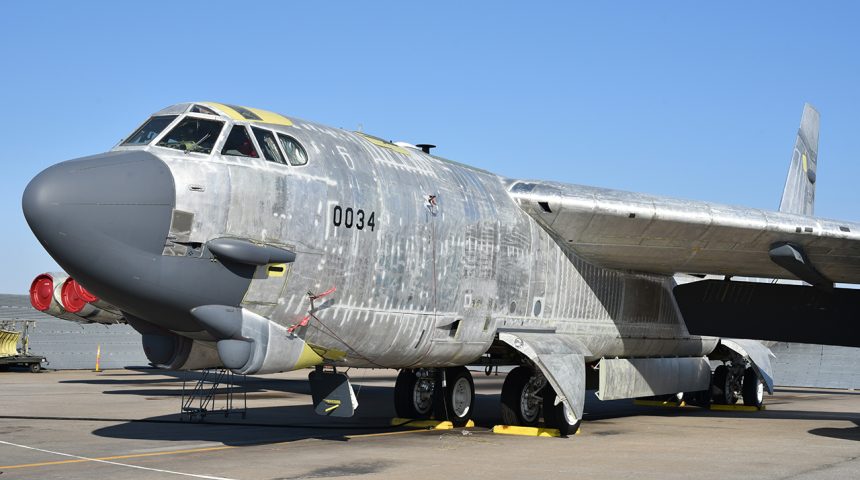“Ghost Rider” and “Wise Guy”, the two only two B-52 Stratofortress bombers to be resurrected from the Arizona desert have been undergoing programmed depot maintenance, before returning to Minot Air Force Base.
Only two B-52 Stratofortress bombers have been restored out of the Boneyard to be returned to the fleet: “Ghost Rider”, tail number 61-0007, and “Wise Guy”, tail number 60-0034.
Both aircraft were retired at the 309th AMARG (Aerospace Maintenance and Regeneration Group) at Davis-Monthan AFB, Arizona, where they were supposed to remain to be cannibalized of parts needed by other front-line BUFFs and never to fly again.
The first to be resurrected was Ghost Rider, that eventually returned to service in 2015 with the 5th Bomb Wing at Minot AFB, North Dakota, after being mothballed for seven years in the desert climate. As reported in detail recently, the second “Lazarus” B-52, nicknamed Wise Guy, spent 10 years in the desert before being resurrected late last year.
The two aircraft were regenerated at the Tinker Air Force Base’s Oklahoma City Air Logistics Complex, where they currently are, undergoing PDM (Programmed Depot Maintenance), a very complex process, that each B-52 undergo every four years, made of heavy checks, during which the aircraft is almost completely disassembled and each part is inspected and all defects are fixed before they are rebuilt and sent back to their home stations as they were (almost) brand new. Even the paint is stripped off the entire airframe so that technicians can analyze every part of the aircraft and make repairs where needed.
Ghost Rider, is currently undergoing routine PDM whereas Wise Guy is undergoing PDM as the final part of a three-phase process to resurrect the aircraft. The aircraft will soon join the fleet at Minot AFB, bringing the number of B-52 bombers mandated by Congress to full strength at 76 aircraft.
We have provided some exclusive photographs and footage of Wise Guy undertaking FCF (Functional Flight Check) ahead of moving to the paint shop that you can find in the article linked here.
A public release provides some interesting details about the two aircraft’s specific regeneration processes:
Though they are both the same type of aircraft, there were many challenges to overcome with each aircraft as it travelled through the regeneration process.
John Raihl, 565th AMXS aircraft section chief, said the biggest challenge with Ghost Rider was establishing a plan to ensure all required inspections, maintenance, and modifications were accomplished on schedule and within budget. The plan was implemented in coordination with the B-52 System Program Office, Logistics and Engineering, as well as the 76th Aircraft Maintenance Group’s 76th Expeditionary Depot Maintenance Flight.
“Using scripting tools, the enterprise team drafted a script that achieved this in addition to maximizing concurrent work across different maintenance disciplines,” said Raihl.
Wise Guy presented the enterprise team with a different challenge: two major electrical wiring projects.
“Rewire I and II projects were the biggest challenges due to the scope of the project, as well as the limited experience we had with those specific wire bundles,” Jennifer Smith, 565th AMXS avionics/electric section chief, said.
Main landing gear structural defects also presented unique challenges for Wise Guy during the initial regeneration phase, as well as during the PDM cycle.
Travis Reese, AFLCMC lead regeneration engineer, said, “Repairs necessary to prepare Wise Guy for first flight presented risk to the overall project. Additionally, these temporary repairs had to be removed and permanently addressed, adding scope and complexity for the technicians in the 565th AMXS structural repair section.”
Additionally, the 76th Commodities Maintenance Group partners had to manufacture all of the wire harnesses from original drawings. This process alone took more than four months prior to the aircraft arriving at Tinker Air Force Base, Smith said.
The experience grown with Ghost Rider translated into important Lessons Learned that the team could apply when working on Wise Guy:
“By utilizing enterprise team meetings ahead of the aircraft’s arrival, we were able to expand Ghost Rider’s process script into a precise script,” said Mike Bassham, 565th AMXS sheet metal section chief. The script process enabled the team to measure milestones for all major jobs for the purpose of keeping the aircraft on schedule and determining where they needed to apply additional resources to tackle constraints, he added.
Jeff Base, 565th AMXS director, explained that hundreds of people across the OC-ALC are involved in regenerating and, or overhauling aircraft requiring a total Team Tinker effort.
“AFLCMC provides engineering and logistics support, the 76th EDMX traveled to the 309th AMARG to prepare aircraft for flight after years in storage, the 76th CMXG overhauls and manufactures parts, the 76th Propulsion Maintenance Group overhauls engines and manufactures parts,” Base said.
David Strawderman, AFLCMC’s B-52 System Program Office regeneration project manager, echoed Base’s comments, adding the motivation and dedication of everyone involved ensured both regeneration programs were successful.
A lot of people were involved in the activities to regenerate Wise Guy: over 100 personnel from nine organizations in less than four months! Pretty impressive. Still, the result is a fully airworthy B-52 ready to generate new missions for several years to come!









